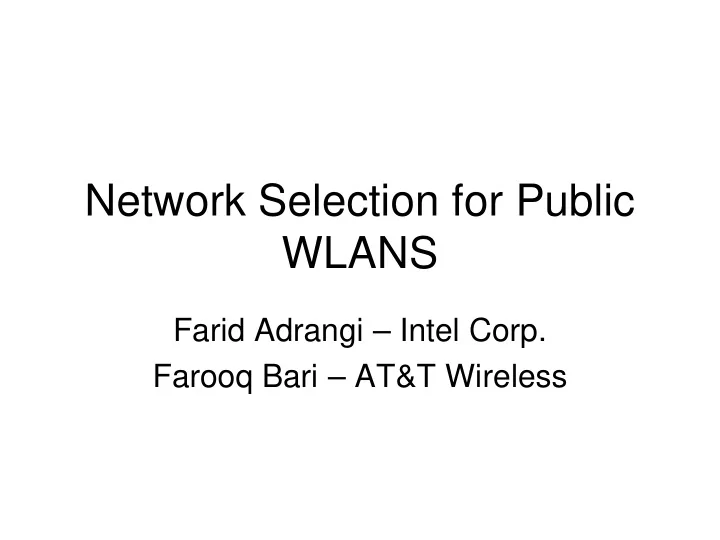

Network Selection for Public WLANS Farid Adrangi – Intel Corp. Farooq Bari – AT&T Wireless
Background • An increasing public WLAN deployment by WISP, 3G, and fixed broadband operators • In roaming situations, a WLAN access network may have roaming relationship with – Several subscriber’s home networks – Several mediating networks, roaming consortiums and brokers, or both • A subscriber’s home network may have roaming relationships with several mediating networks.
Roaming Scenarios Access Network (AN) Home Service Network (HSN) Operator “B” AAA Messages WLAN Operator “A” Operator “E” Access Network (AN) Home Service Network (HSN) Operator “B” WLAN Operator “A” Operator “D” Possible paths for AAA Operator “C” Messages Mediating Networks
Public WLAN Use Cases • Use case 1 - WLAN client moves into a Hotspot advertising the client’s HSN SSID • Use case 2 - WLAN client moves into a Hotspot advertising one or more of WLAN client’s HSN Roaming Partner SSID(s) but not its HSN SSID • Use case 3 - WLAN client moves into a Hotspot advertising only Unrecognized SSIDs HSN : Home Service Network
Problem Statement 1. Access Network Discovery & Selection – Which SSID to attach to? 2. Mediating Network Discovery & Selection – How to route the AAA conversation to the home network? The paper focuses on solving problem #2
Solution Alternatives • Beacon Based / Layer 2 Mechanisms – Beacon extension to carry network information – Multiple SSID advertisement (Virtual AP) • EAP Signaling / Layer 2.5 Mechanisms with NAI decoration – Independent of underlying link layer
Comparison Comparison Criteria Beacon-based Mechanisms EAP-based Mechanisms Ease of Deployment & Requires configuration and provisioning on a No impacts on currently deployed APs Ease of Operations large number of APs Minimal impact on performance of radio Consume radio bandwidth as the information The impact is lesser on radio bandwidth as the bandwidth is broadcasted frequently WLAN Roaming Partner information is only advertised when requested Minimal Latency This mechanism is faster than the EAP This mechanisms is slower relative to Beacon- mechanisms since association to Access Point based mechanisms, since WLAN client has to is not needed to discover the Roaming Partners associate to an Access Point before it can of the WLAN Operator. discover Roaming Partners of the WLAN Operator No impact on current IEEE or IETF Possible impact on IEEE 802.11 standards No impact standards Backward compatibility with current Beacon-based mechanisms can impact EAP-based mechanisms will require an update infrastructure currently deployed APs of AAA proxy in the WLAN Pros Cons
Put it all together • Client attempts to directly authenticate to its home network based on – Available SSID list (obtained through 802.11 scanning) – Preferred SSID list (provided and provisioned by the home operator) • Client attempts to authenticate to his home network via an intermediary base on – Available intermediary network list (Obtained through EAP signaling) – Preferred intermediary network list (provided and provisioned by the home operator) – Use of NAI decoration
Related work • IETF – Problem Statement • http://www.ietf.org/internet-drafts/draft-ietf-eap-netsel-problem-01.txt • http://www.ietf.org/internet-drafts/draft-ietf-roamops-2486bis-01.txt – Identity Selection hint • http://www.ietf.org/internet-drafts/draft-adrangi-eap-network- discovery-02.txt • IEEE – WIEN (Wireless Interworking with External Networks) • Network Detection & Selection, Beacon scalability, 3G keying issues, Policy enforcement, traffic enforcement, charging, etc • 3GPP Release 6 / GSMA IR61 – AAA routing (based on EAP signaling) – Payload routing
Questions?
Backup …
AAA - Public WLAN Infrastructure RADIUS Proxy HSN RADIUS WLAN Client Access Point Server server EAP EAPOL RADIUS UDP IP
Recommend
More recommend